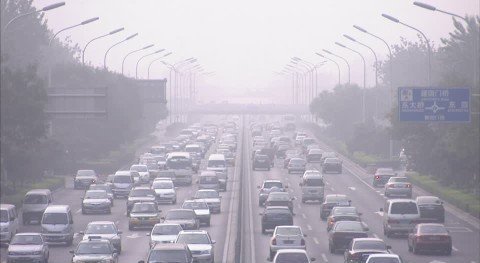Beicology: A New Solution That Might Finally Rid Beijing of Its Smog
Smog hit hazardous levels on Nov 26, and despite the crystal clear skies of the following day, Beijingers didn’t exactly breathe a sigh of relief. Despite a growing number of overall clear air days, the capital’s haze hasn’t diminished entirely. However, a recent study may point to a better way forward for environmental officials looking to finally rid us of such persistent pollution.
The study, coordinated jointly between researchers at Harvard, Tsinghua University and the Harbin Institute of Technology, discovered some alarming results. Chief among them: crackdowns on coal-burning between 2013-2017 yielded less progress than expected. However, some good news is that the study revealed that sources of formaldehyde pollution, especially vehicle and chemical and oil refinery emissions, are bigger factors than initially thought, meaning a greater focus on those polluters should provide more successful results in the future.
Officials have been targetting coal as the primary pollutant because their instruments were detecting high levels of sulfur compounds, and erroneously determined they were sulfates. The new study says much of those sulfur compounds were instead hydroxymethane sulfonate (HMS), which is a result of sulfur dioxide having a chemical reaction to formaldehyde in smog.
“The type of instruments used to measure particulate matter in Beijing can easily confuse the two,” an article on EcoWatch about the new study concluded. This resulted in air quality levels falling short of expectations after anti coal burning measures were put in place after 2013.
One of the study’s researchers, Jonathan M. Moch, told the Boston Globe: “[Chinese authorities] went a very long way to get to this result. We think there could have been a shorter way if they had gone straight at formaldehyde.”

Disheartening as all that squandered time may seem, it’s not all bad news. Now officials seem to be on the right track, with sulfur dioxide levels dropping below formaldehyde for the first time last winter, resulting in less HMS and better air quality levels. Going forward, Moch and his cohorts will zero in on HMS levels in Beijing as they gather more data.
In fact, Moch struck a very positive note when asked by the Beijinger about these findings, saying he is "quite optimistic about the future. China's experience reducing sulfur dioxide showed that they can make dramatic reductions in emissions once officials make a decision."
He adds, "I'm hopeful that in the future, if both formaldehyde and sulfur dioxide emissions are brought down, China can avoid severe smog episodes even when there are weather conditions that trap pollutants and enhance haze formation."
To achieve that goal, however, Moch has a blunt solution: "The major source of formaldehyde emissions in the Beijing area is the transportation sector. So improving the efficiency of vehicles is a key way to go at reducing formaldehyde emissions."
In case you've magically forgotten what bad smog is like, here's an illustrated guide.
Photo courtesy of harvard.edu







